Research on RBV Control Strategy of Large Angle Maneuver
Abstract
Considering the hypersonic aerospace vehicle, with high dynamic, strong varying parameters, strong nonlinear, strong coupling, and the complicated flight environment, conventional flight control methods based on linear system may become invalid. To the high precision and reliable control problem of this vehicle, nonlinear flight control strategy based on neural network robust adaptive dynamic inversion is proposed. Firstly, considering the nonlinear characteristics of aerodynamic coefficients varying with Mach numbers, attack angle, and sideslip angle, the complete nonlinear 6-DOF model of RBV is established. Secondly, based on the time-scale separation, using the nonlinear dynamic inversion control strategy achieves the pseudolinear decoupling of RBV. And then, using the neural network with single hidden layer approximates the dynamic inversion error for system model uncertainty. Next, the external disturbance and network approximating error are suppressed by robust adaptive control. Finally, using Lyapunov’s theory proves that all error signals of closed loop system are uniformly bounded finally under this control strategy. Nonlinear simulation verifies the feasibility and validity of this control strategy to the RBV control system.
1. Introduction
To meet the development of space research, space tourism, and military requirement and achieve the goal of speediness, high reliability, reusability, and low cost, the hypersonic aerospace vehicle especially reusable launch vehicle, RLV, emerges [1–6].
Reusable boosted vehicle (RBV) experiences the subsonic, transonic, and supersonic phase during the whole flight, which the aerodynamic coefficients, dynamic pressure, and flight altitude acute change, especially in the large attitude adjusting phase with supersonic and large angle of attack. Considering the imprecise aerodynamic model, abominable flight condition at the high altitude, great system perturbation, and interference, gain scheduling and PID control strategy based on linearized with small disturbances cannot apply to the flight control system of RBV large attitude adjusting phase design. It is necessary to design RBV control system by using nonlinear control method.
Shtessel designed the sliding mode control system of X-33 based on the time-scale separation principle, which has achieved the great control performance [7–9]. On the basis, the designer estimated the real-time perturbation and interference through introducing the sliding mode observer, which not only could suppress the buffeting, but also could improve the robust performance of system. In case of solving the buffeting problem of sliding mode control method effectively, it could be one of the efficient methods to solve the uncertain nonlinear system.
Linear parameter varying (LPV) control methodology [10] is an extension of H∞ control theory [11, 12] to the linear varying parameter system. To the nonlinear flight control system, many scholars have studied the application of LPV control methodology [13–15]. Nevertheless, using LPV control methodology needs to transform the nonlinear system to the LPV system, there is no uniform evaluation criterion to judging the approximative transform.
Nonlinear dynamic inversion (NDI) is the general nonlinear control strategy and methodology. Snell et al. [16] applied NDI to the supermaneuverable aircraft firstly. Bugajski and Enns [17] designed the universal architecture of flight control system design, the core of which was the structure block. Using the above method designed the control law of the large angle of attack aircraft. The simulation results verified that this methodology could satisfy the performance requirement of supermaneuvering flight control, but it must be pointed out that modeling error and serious unusual aerodynamic effect cause the decreased robustness in the NDI control law. Farland and D’Souza [18] designed the attitude control system of lifting body reentry vehicle by NDI. The writer indicated that, to the parameter perturbation and external interference, using robust control theory strengthens the robustness of system under the NDI. NDI control methodology requires the accurate model. In fact it is impossible. Hence, it is necessary to combine the other control methods to eliminate the influence of inaccurate model.
2. Flight Timing and Trajectory of RBV
The RBV in this paper is the reusable vehicle which uses the rocket back to the launch site. Its flight processes as follows: after the separation from the disposable core stage (upper stage), RBV adjusts the attitude under RCS system in the tail during the sliding by inertia itself. When attitude angle of RBV reaches about 180°, the adjust phase finishes, and the head of RBV points to the direction of returning to the launch site. After the adjusting phase, with secondary ignition of RBV rocket engine (restricting the overload of secondary shut-off point), varying thrust regulator is used to adjust the flight velocity to satisfy the constraint condition of reentry. Afterwards, the vehicle experiences the fixed attitude dropping phase and the adjusting attitude phase and then enters the energy management and autonomous landing phase. The flight timing and trajectory of the RBV are shown in Figure 1.
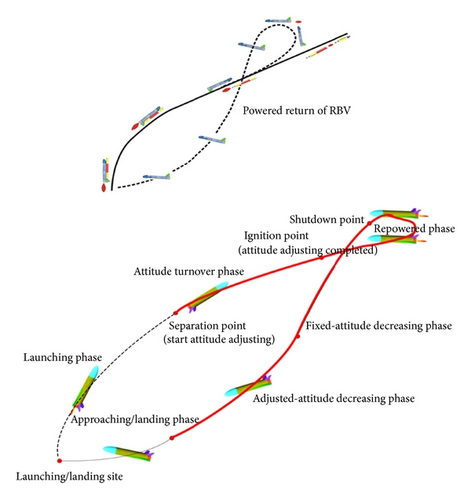
Reusable boosted vehicle (RBV) experiences the subsonic, transonic, and supersonic phase during the whole flight, which the aerodynamic coefficients, dynamic pressure, and flight altitude change acutely. For this, the differences of the dynamic characteristics of RBV are significant during all of the flight phase. Besides that, there is a great different between the aerodynamic characteristics of RBV and the conventional vehicle. This paper focuses on the large attitude adjusting phase after the RBV separating between the core stages. To implement the high reliability and precision of RBV, the nonlinear model is built according to the flight environment.
3. RBV System Modeling
This paper examines the problem of a nonaxisymmetric airframe which is flown in a large angle of attack. In the trajectory tracking problem (see Figure 2, body coordinate system of RBV), and the guidance law produces acceleration commands in the body y and z axes based on nominal trajectory. These acceleration commands can be converted into commands in roll angle and angle of attack, which are fed into the autopilot. The task of the controller is to track commands in angle of attack and roll angle, while keeping sideslip angle small. There are many examples of angle of attack autopilots in the literature. The reader is referred to [16, 19] for treatments of autopilots that control angle of attack.
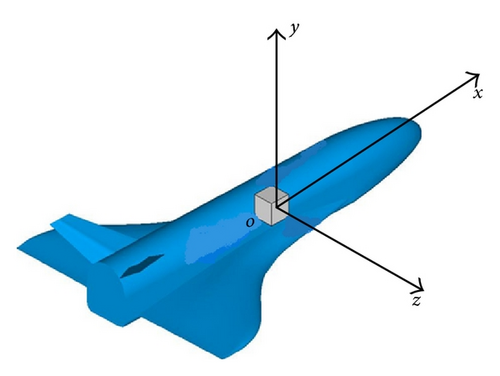
3.1. Dynamic Model for Attitude Adjusting Phase of RBV
3.2. Aerodynamic Data Model of RBV
In order to design the flight control system of RBV in this paper conveniently, aerodynamic data models of RBV are built in the velocity coordinate system, and body coordinate system respectively [25].
4. Robust Adaptive Inversion Control Based on Neural Network
4.1. Single Hidden Layer Neural Network
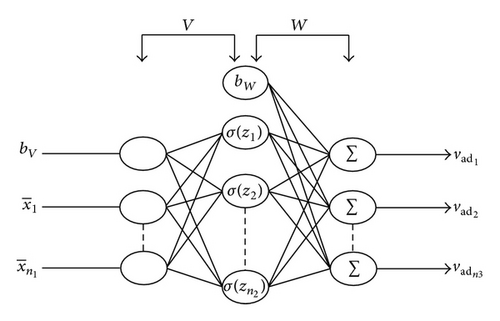
In addition, the offset term bV, bW ≥ 0 in (4) and (6), the objective of which is to contain the threshold value of neurons in the hidden layer and to contain the output layer to the weight matrix, to implement the real-time adjusting of the threshold value of neurons.
4.2. Nonlinear Dynamic Inversion
The objective of control system design of nonlinear system as (8) is to seek the control input u, through which the system output y could track the expected output and time-varying trajectory yd according to the certain precision and ensure the all the state variable of the closed loop be bounded.
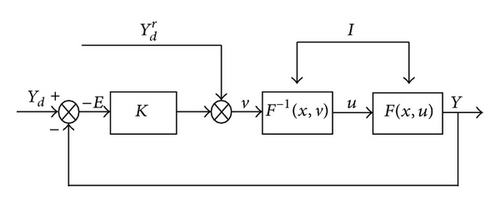
4.3. System Control Strategy
In (8), there are many inexact factors in the nonlinear system such as unmodeled dynamic, parameter perturbation, and external disturbance. Considering that the nonlinear dynamic inversion needs the accurate system model, the control strategy to counteract the model uncertainty must be proposed to guarantee the system tracking performance based on the nonlinear dynamic inversion method.
The robust adaptive inversion control based on neural network is shown in Figure 5.
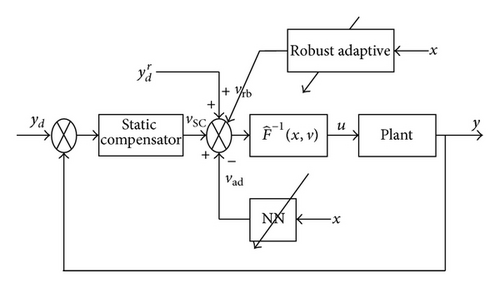
- (1)
Firstly, the static compensator vsc designed by nonlinear dynamic inversion method is exponent stable in the nominal neighborhood and satisfies the performance requirements of closed loop system in the nominal condition (i.e., Δ = 0);
- (2)
Secondly, according to the strong nonlinear mapping ability of neural network, the inverse error Δ (x, v) mapped by uncertainty Δ (x, u) is approximated by neural network output vad when uncertainty condition exists.
- (3)
Finally, designing the robust adaptive control term vrb overcomes the influence of approximation error, then a better adaptive robust performance of entire closed loop system is achieved.
5. Analysis and Design of Control System
Based on the control strategy in the above third chapter, the neural network robust adaptive inversion control law is designed. And then, the stability of the closed loop system is proved strictly in the theory. Here, the input of SHLNN is , where E = x − xd, x is the system state, xd is the expected system state, and vad is the neural network output.
Assumption 1. Giving arbitrary , there are the ideal neural network weight matrixes V* and W* to make the single hidden neural network uniform approximating the inverse error function Δ(x, v) which is continuous and derivable in the compact set . That is,
Assumption 2. Generally speaking, the ideal neural network weight matrixes V* and W* are unknown and may be not only. Therefore V* and W* can be defined:
For ideal weight matrixes V*and W* being unknown, let and be defined to describe the estimated value of neural network ideal weight matrix.V0 and W0 are the initial value of network, where and are the estimated error of neural network weight, respectively. Based on this estimated value, the online neural network approximation vad is
Now the dynamic error equation of closed loop system is
As A is Hurwitz matrix, there exists only positive definite matrix P with respect to the following Lyapunov function, which satisfies
Considering the Taylor expansion of in ,
Substituting (26) by Taylor expansion of network approximation inverse error, the dynamic error equation of the closed loop system is as follows:
Introducing the operator vec to the matrix M ∈ Rn×m, in order to analysis the following theory conveniently,
Let . Considering the composite errors vector , the compact set defined as follows is
Assumption 3. BR is the largest hypersphere in compact set Dς and satisfies
Let vR be the minimum value given by following function V along the bound of hypersphere BR:
Define the following compact set:
Theorem 4. To the nonlinear uncertain system composed by (8), (15), and (18), the following designed control law based on neural network robust adaptive dynamic inversion satisfies all the error signals ς(t) uniformly bounded considering the conditions of Assumptions 1–3 when the initial value ς(0) of composite errors belongs to the compact set ΩR. When t > T0, the trajectory of arbitrary initial error signals from ΩR will enter the boundary of ΩC in the finite time, the final value of which is ,
Proof. The Lyapunov function of system is
Solving the time derivative of (45) and using (27) and (35) yield
Substituting the neural network robust adaptive dynamic inversion control law (42)~(45) to (46) yields
Simplifying the above equation,
Amplifying (48) according to the conditions of s* = 1 + sw and yields
Simplifying (49) based on the given estimated error yields
Using the following inequality,
Simplifying (50) yields
Giving definitions as follows:
Equation (55) can be written:
From (56), it is obvious that when satisfying the following inequality:
From (57), it is obvious that if we satisfy the , (58) must be established, which indicates that there is a compact set. In the out of the compact set, is established. Defining the compact set proves that all of the error signals are ultimately bounded. Defining the following the hypersphere [35] firstly is
There is beyond the compact set BC. From (44), it yields
Let vC be the maximum of function V along the boundary of the hypersphere BC:
The compact set ΩC is
From (38) and Figure 6, it can be proved that BC ⊂ ΩC ⊂ ΩR ⊂ BR. If the composite initial errors ς(0) ∈ ΩR, all of the error signals are ultimately bounded in the closed loop system. According to the Lyapunov stability theorem, when t > T0, the trajectory of arbitrary initial error signals from ΩR will enter the boundary of ΩC in the finite time, the final value of which is . The proof is finished.
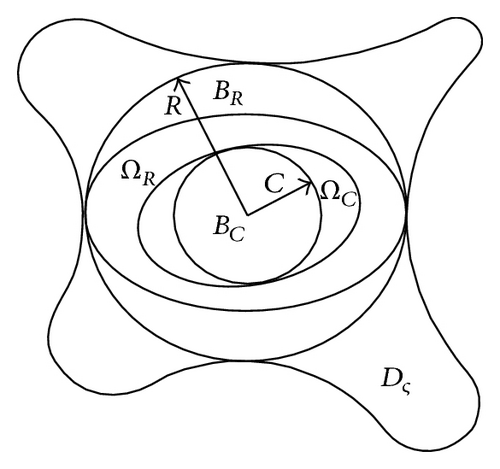
6. Simulation and Validation of RBV
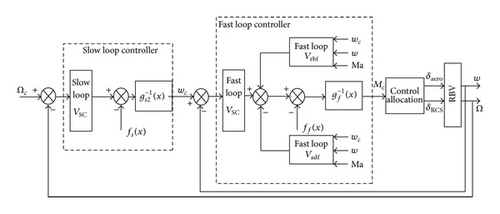
The parameter setting and initial condition of system simulation reference [31]. The simulation results of command angle tracking during large attitude adjusting phase are shown in Figure 8.
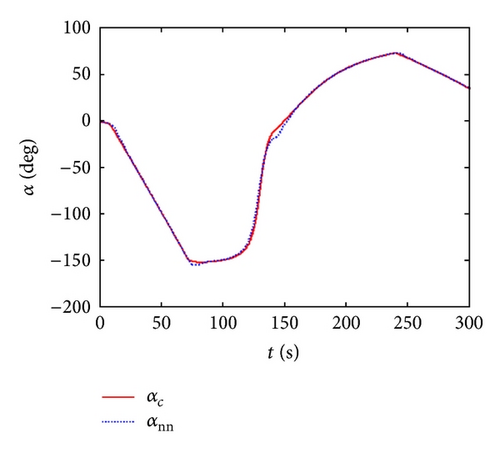
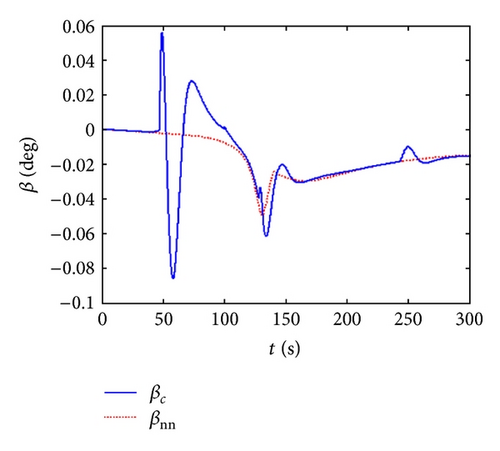
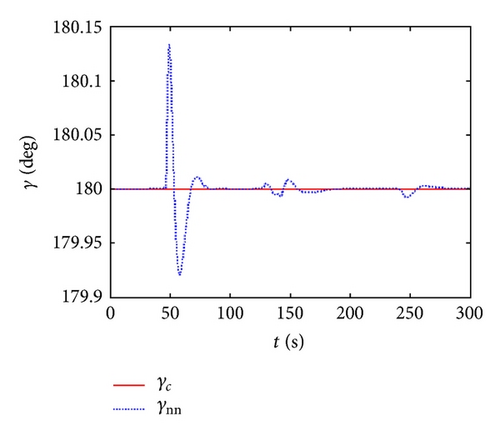

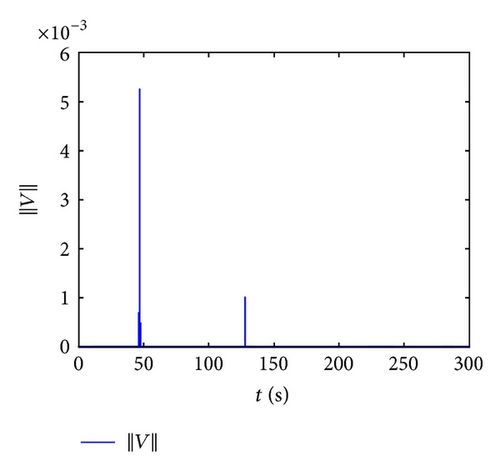
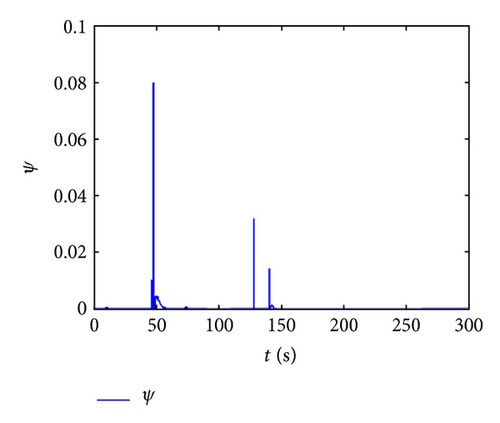
Figure 8 indicates the whole flight simulation curves of RBV control system during the turn period and reentry phase the produced from guidance module which is the control system total input signals. The subscript “nn” represents the simulation results proposed by neural network robust adaptive inversion control law when aerodynamic parameter perturbation exists. “c” is the initial command value. ∥V∥, ∥W∥ are the weight norm of neural network matrixes.
Figure 8 presents the simulation curves of RBV flight control based on neural network robust adaptive inversion. From the curves of guidance command tracking, the system output can track the change of system input finally. The sideslip angle and roll angle have the tracking errors during the attitude adjusting phase for 46.9 s, but both are in the tolerance range. Besides, after accomplishing the adjusting phase at 140 s, the thrust increasing produces some oscillations, which have great influence on angle of attack, but little to sideslip angle and roll angle. The errors of sideslip angle and roll angle are in the tolerance range, and when it is higher than 80 km, the error of angle of attack has little influence on the final tracking effect. From above figures, it can be proved that the final tracking accuracy is high. Analyzing the weight norm and robust adaptive coefficients, the neural network adaptive law is effective and can eliminate the inverse errors. The network weight coefficients not only represent the parameter perturbation and the influence caused by parameter perturbation with varying as system adaptive change, but also represent the influence of eliminating the inverse errors which tended to be stable.
7. Conclusions
According to the uncertainty of RBV model, the robust adaptive inversion control strategy based on neural network is proposed in this paper. The nonlinear simulation verifies the validity to this methodology. Using Lyapunov theory proves the ultimate uniform boundedness of RBV closed loop control system. The simulation results indicate that when aerodynamic moment parameter perturbation is 30%, this methodology can reduce the requirement of RBV model accuracy and improve the control system robustness during the adjusting phase and reentry phase of RBV.
Conflict of Interests
The authors declare that there is no conflict of interests regarding the publication of this paper.
Acknowledgments
This research was supported under National Natural Science Foundation of China (no. 11372080), China Postdoctoral Science Foundation (no. 20110491028), Central University Foundation of Basic Scientific Research (no. HEUCFZ1126, no. HEUCFZ1120), and Natural Science Foundation of Heilongjiang Province (no. QC2011C020). The authors thank Professor CUI Naigang and CHEN Weidong for their help. Also the authors are indebted to CHEN Yangyang, TANG Xiaoping, and ZENG Kui for their continuous help. Finally, the authors thank the reviewers for their helpful comments and insight.




